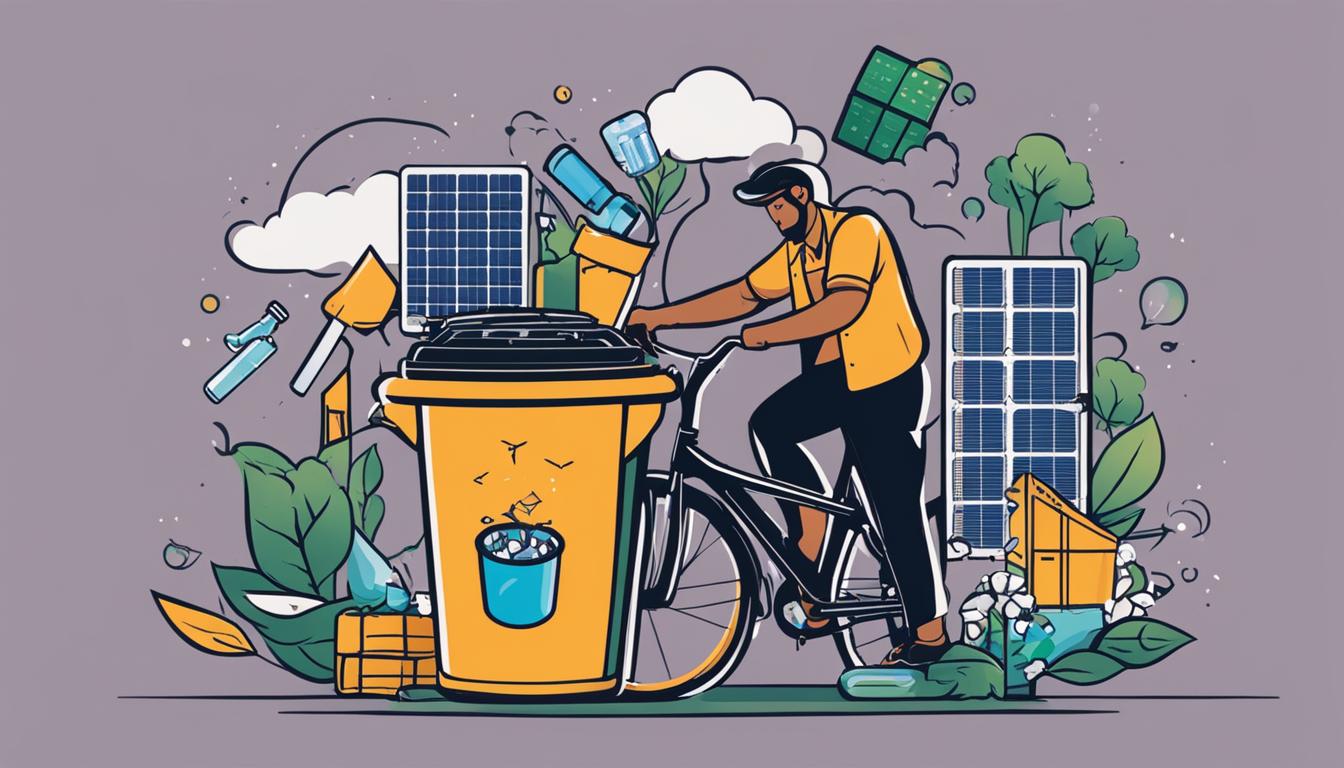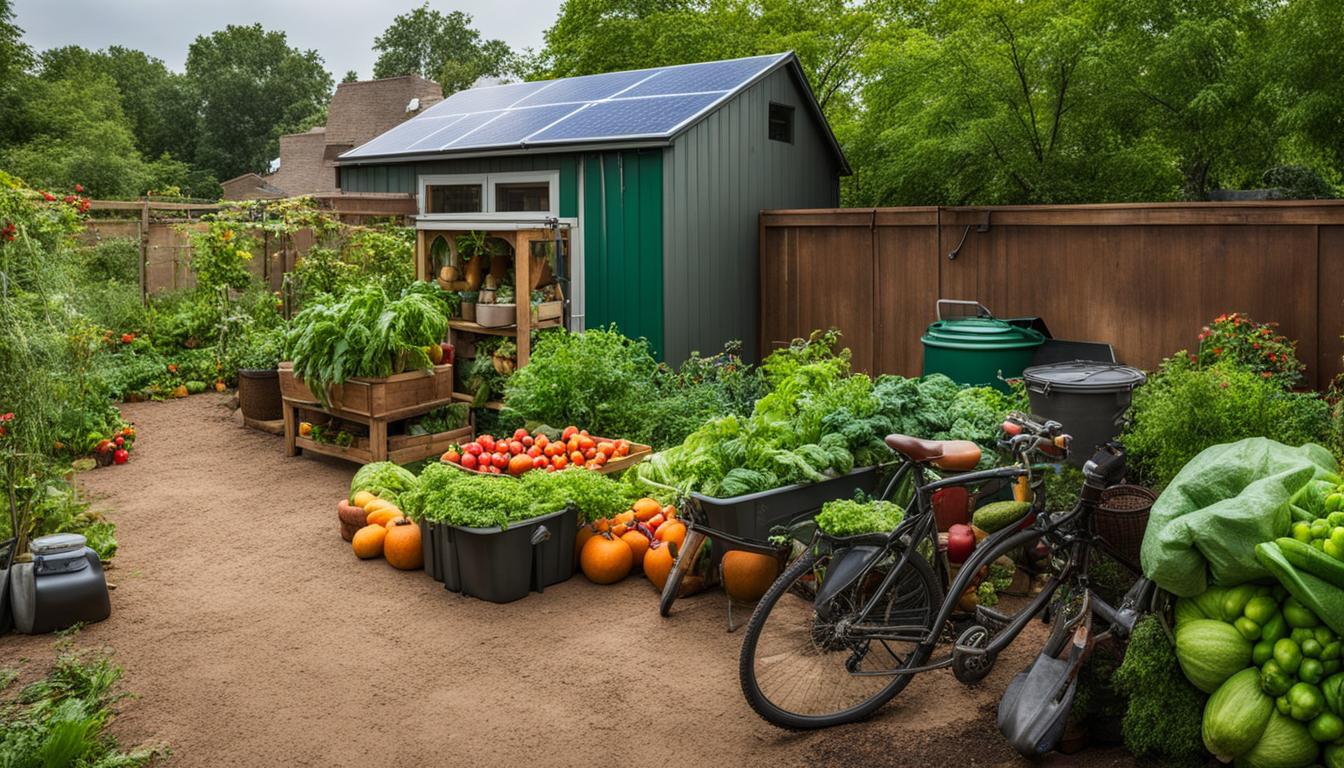Conservation International emphasizes the importance of individual action in protecting the planet. By implementing sustainable living practices in our daily lives, we can contribute to significant improvements for the environment. Here are some practical tips to help you lead a more eco-friendly and sustainable lifestyle.
Key Takeaways:
- Make eco-friendly choices in your daily life
- Reduce your carbon footprint
- Contribute to a greener future
- Implement sustainable living practices
- Protect the planet through individual action
Retire Your Dryer and Switch to a Drying Rack
When it comes to sustainable home tips and environmentally friendly choices, one simple change you can make is retiring your dryer and opting for a drying rack. By air-drying your clothes whenever possible, you not only save money and energy but also prolong the life of your garments.
Dryers consume a significant amount of electricity, contributing to your household’s carbon footprint. By using a drying rack, you eliminate the need for electricity altogether and reduce your environmental impact. Plus, your clothes will thank you too!
Did you know? Air-drying your laundry can minimize wear and tear on fabrics, helping them last longer and reducing the need for replacement.
To get started, simply set up a drying rack in a well-ventilated area, such as your laundry room, balcony, or backyard. Hang your clothes on the rack and let nature do its work. Not only will you enjoy the fresh scent of air-dried laundry, but you’ll also see the impact in your energy bills.
Fun fact: According to the U.S. Department of Energy, a typical clothes dryer uses about four times more energy than a washing machine!
So, why not take this small step towards sustainable living? Retiring your dryer and embracing the use of a drying rack is a simple yet effective way to create a more sustainable home and make environmentally friendly choices.

Switch to LED or CFL bulbs
When it comes to sustainable living habits, small changes in our everyday choices can make a big difference for the environment. One simple step you can take is to switch from traditional incandescent light bulbs to energy-efficient alternatives like LED or CFL bulbs.
Unlike incandescent bulbs, LED (Light Emitting Diode) and CFL (Compact Fluorescent Lamp) bulbs waste minimal electricity and emit significantly less heat. By making this switch, you can lower your energy consumption and reduce your carbon footprint. LED and CFL bulbs use as little as 20% of the electricity used by incandescent bulbs, making them a greener option for everyday lighting needs.
LED bulbs, in particular, have a longer lifespan than incandescent bulbs, meaning you won’t have to replace them as frequently. This not only saves you money in the long run but also reduces the number of bulbs that end up in landfills.
So, consider swapping out your old incandescent bulbs for LED or CFL alternatives. Not only will you be making a more sustainable choice, but you’ll also enjoy the benefits of energy savings and longer-lasting bulbs.

Make the switch to LED or CFL bulbs today for a greener and more eco-conscious lifestyle.
Refresh your air filters and adjust your thermostat
One of the essential sustainable home tips is to regularly clean or replace your HVAC filters. Dirty filters can restrict airflow, making your heating and cooling systems work harder and consume more energy. By keeping your filters clean and efficient, you not only improve the air quality in your home but also reduce energy consumption and extend the lifespan of your HVAC equipment.
Additionally, adjusting your thermostat can make a significant difference in your energy consumption. By setting your thermostat 7 to 10 degrees lower in winter and higher in summer when you’re away from home, you can save up to 10% on your annual energy bill without compromising your comfort. This simple practice helps you practice eco-friendly living suggestions and reduce your carbon footprint.

By refreshing your air filters regularly and adjusting your thermostat, you can optimize energy efficiency in your home and contribute to a more sustainable lifestyle. These small eco-friendly living suggestions have a big impact on the environment and your wallet. Start implementing these sustainable home tips today, and enjoy a greener future for yourself and the planet.
Switch to Rechargeable Batteries

In our quest for a more sustainable lifestyle, one small change we can make is to switch from traditional, single-use alkaline batteries to rechargeable batteries. Not only will this switch save you money in the long run, but it will also have a positive impact on the environment.
Did you know that billions of dollars worth of batteries end up in landfills each year? By using rechargeable batteries, we can significantly reduce this waste and lessen the burden on our planet. These batteries can be reused hundreds of times, saving valuable resources and preventing harmful chemicals from leaching into the ground.
Not only are rechargeable batteries better for the environment, but they also provide long-lasting power for your devices. They are a reliable and cost-effective option, ensuring that you always have the energy you need without constantly buying and disposing of single-use batteries.
“Switching to rechargeable batteries is a simple yet effective green living idea that anyone can implement. It’s a small change with a big impact.”
When your rechargeable batteries eventually reach the end of their lifespan, it’s important to recycle them properly. Many local recycling centers accept batteries, so be sure to find a drop-off location near you. Recycling batteries prevents toxic chemicals from entering the environment and allows valuable metals and materials to be reused.
By switching to rechargeable batteries, we can embrace sustainable living strategies and contribute to a greener future. Let’s take this small step together and make a big difference for our planet.
Choose Standard Shipping and Dine In Instead of Eating Out
When it comes to sustainable living habits, every choice you make can have an impact. Two areas where you can make a difference are in your shopping and dining habits. By opting for standard shipping and choosing to dine in instead of eating out, you can contribute to a more eco-conscious lifestyle.
When shopping online, consider selecting the option for the fewest packages and slower shipping. This reduces unnecessary emissions from multiple deliveries. By consolidating your purchases and waiting a little longer for them to arrive, you can help minimize the environmental impact of online shopping. It may also be worth exploring eco-friendly packaging options or brands that prioritize sustainable shipping practices.
“Choosing standard shipping not only reduces transportation emissions but also encourages businesses to adopt more sustainable practices.”
When it comes to dining out, many restaurants use a significant amount of energy for non-food related purposes. By choosing to cook and eat at home, you can save money and reduce your carbon footprint. Cooking your meals allows you to control the ingredients and reduce food waste, leading to a more sustainable lifestyle. Enjoying homemade meals with friends and family also creates opportunities for quality time and connection.

By making conscious choices in these areas, you can contribute to a more sustainable future. Choose standard shipping to minimize packaging waste and emissions, while enjoying home-cooked meals to reduce energy consumption and waste. Small actions like these add up and can make a significant impact on your eco-conscious practices. Start incorporating these habits today and be a part of the solution for a greener tomorrow.
Go Meat-Free at Least One Day a Week
Did you know that beef production significantly contributes to greenhouse gas emissions and water usage? By going meat-free, especially avoiding beef, at least one day each week, you can reduce your personal carbon footprint and contribute to a more sustainable food system.
Eating less meat has numerous benefits for both the environment and your health. Livestock farming, especially beef production, requires vast amounts of resources, including land, water, and feed. The process of growing animal feed and raising livestock also releases substantial greenhouse gases into the atmosphere.
By choosing to go meat-free for at least one day a week, you can help reduce the demand for animal products and the environmental impact associated with their production. This small change in your diet can have a significant positive effect on the planet.
By exploring plant-based alternatives, such as legumes, whole grains, fruits, and vegetables, you’ll discover a wide variety of delicious and nutritious meals that don’t require meat. Incorporating more plant-based foods into your diet not only reduces your carbon footprint but also provides essential nutrients and promotes overall well-being.
“By going meat-free for at least one day a week, you can contribute to a more sustainable and eco-friendly food system.”
There are also ethical considerations when it comes to food choices. Many factory farms employ practices that prioritize profit over animal welfare, causing harm to animals and the environment. By reducing your meat consumption, you can support more humane and sustainable farming practices, promoting a healthier and more compassionate food system.
So, why not challenge yourself to go meat-free at least one day a week? It’s a small step that can make a big difference for the planet and your own well-being.

Buy Locally Produced Food and Grow Your Own
Purchasing locally produced food is an excellent sustainable living strategy that allows you to support your community and reduce greenhouse gas emissions associated with long-distance transportation. When you choose locally sourced food, you’re not only getting fresh and seasonal produce, but you’re also minimizing your carbon footprint.
Consider participating in Community Supported Agriculture (CSA) programs as a convenient way to access locally grown fruits, vegetables, and other farm products. CSA programs often deliver fresh produce directly to your door, making it easier than ever to enjoy a variety of locally sourced foods.

Additionally, growing your own herbs, fruits, and vegetables can be a rewarding and eco-friendly experience. By cultivating your own garden, you have full control over the growing process, ensuring that no harmful chemicals or pesticides are used. Not only does this promote a healthier diet for you and your family, but it also reduces emissions related to shipping and refrigeration.
Reduce standby power and opt for refurbished electronics
One often overlooked way to make your home more sustainable is by reducing standby power consumption. Many electronic devices continue to draw power even when they are not in use, contributing to unnecessary energy waste. By simply unplugging these devices or using power strips with an on/off switch, you can eliminate standby power and save up to 10% on your energy bill.
Additionally, when it’s time to upgrade or replace your electronics, consider opting for refurbished units instead of brand new ones. Refurbished electronics are devices that have been restored to their original working condition, often with a lower price tag. By choosing refurbished electronics, you are not only saving money but also reducing the environmental impact of manufacturing and shipping new products.
To further emphasize the importance of reducing standby power and choosing refurbished electronics, let’s take a look at the following statistics:
“Standby power consumption accounts for up to 10% of the energy bill in an average household.” – Energy Star
“Choosing refurbished electronics over new products can save up to 80% of the energy and resources used in manufacturing.” – Green Electronics Council
Unplugging for a Greener Home
Unplugging electronic devices when they are not in use is a simple yet effective way to reduce energy waste. By eliminating standby power, you can contribute to a more sustainable home and lower your carbon footprint. Make it a habit to unplug chargers, televisions, gaming consoles, and other devices when they are not actively being used. You can also consider using smart power strips that automatically cut off power to devices when they are not needed.
Every small action adds up, and by reducing standby power, you can make a significant impact on your energy consumption and reduce your environmental footprint.
The Benefits of Choosing Refurbished Electronics
When it comes to upgrading or replacing your electronic devices, considering refurbished options can be a win-win. Not only do refurbished electronics often come at a lower cost compared to new products, but they also have a reduced environmental impact. By opting for refurbished devices, you are extending the lifespan of electronics and preventing them from ending up in landfills prematurely.
Refurbished electronics undergo thorough testing and repairs to ensure they meet quality standards. Many reputable manufacturers and retailers offer refurbished options for smartphones, laptops, tablets, and other electronic devices. By choosing refurbished electronics, you are making a sustainable choice that supports the circular economy and reduces electronic waste.

By reducing standby power consumption and opting for refurbished electronics, you can actively contribute to a more sustainable and eco-friendly lifestyle. These small changes in your daily habits can have a significant positive impact on the environment. Start implementing these practices today and be part of the solution for a greener future.
Conclusion
Embracing a more sustainable lifestyle is essential for protecting the planet. By implementing these practical tips, you can make eco-friendly choices, reduce your carbon footprint, and contribute to a greener future. Small changes in our daily lives add up to significant improvements for the environment. Start your journey towards sustainable living today!
FAQ
What are some practical tips for a more sustainable lifestyle?
Here are some practical tips to help you lead a more eco-friendly and sustainable lifestyle.
Why should I retire my dryer and switch to a drying rack?
By switching to a drying rack, you can save money and energy, prolong the life of your clothes, and contribute to a more sustainable home.
What are the benefits of switching to LED or CFL bulbs?
LED, CFL, or halogen bulbs use significantly less electricity compared to traditional incandescent bulbs, reducing energy consumption and lowering your carbon footprint.
How can I improve the efficiency of my HVAC system and reduce energy consumption?
Regularly cleaning or replacing your HVAC filters and adjusting your thermostat by 7 to 10 degrees when you’re away from home can significantly improve efficiency and save on your energy bill.
Why should I switch to rechargeable batteries?
Switching to rechargeable batteries saves money in the long run and helps reduce the billions of dollars worth of batteries that end up in landfills each year.
What can I do to reduce emissions when shopping online and dining out?
Choose the option for the fewest packages and slowest shipping when shopping online, and opt for dining in instead of eating out to reduce unnecessary emissions and energy usage.
How can going meat-free help in leading a sustainable lifestyle?
Going meat-free, especially avoiding beef, at least one day each week can significantly reduce your personal carbon footprint and contribute to a more sustainable food system.
Why should I buy locally produced food and grow my own?
Purchasing locally produced food reduces greenhouse gas emissions associated with long-distance transportation. Participating in Community Supported Agriculture programs and growing your own food also helps to reduce emissions related to shipping and refrigeration.
How can I reduce standby power consumption and choose more eco-friendly electronics?
Unplug electronic devices when not in use to eliminate standby power consumption. Additionally, consider purchasing refurbished electronics to reduce the environmental impact of manufacturing and shipping.
How can implementing these practical tips contribute to a more sustainable lifestyle?
By implementing these practical tips, you can make eco-friendly choices, reduce your carbon footprint, and contribute to a greener future. Small changes in our daily lives add up to significant improvements for the environment.


